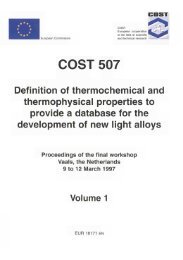Susana Isabel Ferreira da Silva de Sá ESTROGÉNIOS E ...
Susana Isabel Ferreira da Silva de Sá ESTROGÉNIOS E ...
Susana Isabel Ferreira da Silva de Sá ESTROGÉNIOS E ...
Create successful ePaper yourself
Turn your PDF publications into a flip-book with our unique Google optimized e-Paper software.
Brain Research (Aceite para publicação)<br />
Role of Neural Afferents as Mediators of Estrogen Effects on<br />
the Hypothalamic Ventromedial Nucleus<br />
<strong>Susana</strong> I. <strong>Sá</strong>*, Pedro A. Pereira, Manuel M. Paula-Barbosa, and M. Dulce Ma<strong>de</strong>ira<br />
Department of Anatomy, Porto Medical School, University of Porto, Porto, Portugal<br />
Keywords:<br />
Plasticity<br />
Synapses<br />
Neural afferents<br />
Estrogens<br />
Progesterone receptors<br />
Ventromedial nucleus<br />
1. Introduction<br />
ABSTRACT<br />
The effects of estrogens on the ventrolateral division of the hypothalamic ventromedial nucleus<br />
(VMNvl) are essential for its role in the regulation of female sexual behavior. Enhanced<br />
synaptogenesis and induction of progesterone receptors (PRs) are hallmarks of the actions of<br />
estrogens on the VMNvl. To investigate the influence of neural afferents in mediating these effects,<br />
we estimated the number of spine and <strong>de</strong>ndritic synapses per neuron and the total number of PR-<br />
immunoreactive neurons in ovariectomized rats treated with either estradiol benzoate or vehicle, after<br />
unilateral VMN <strong>de</strong>afferentation. The estimates were performed in<strong>de</strong>pen<strong>de</strong>ntly in the VMNvl of the<br />
<strong>de</strong>afferented and contralateral si<strong>de</strong>s, and in the VMNvl of unoperated rats (controls). The<br />
administration of estradiol benzoate did not induce any increase in the number of synapses of the<br />
<strong>de</strong>afferented VMNvl. In the contralateral VMNvl, the synaptogenic effects of estrogen were apparent,<br />
but still reduced relative to the control VMNvl, where a 25% increase in the total number of synapses<br />
was observed after estrogenic stimulation. In the absence of estrogenic stimulation, i.e., in basal<br />
conditions, <strong>de</strong>afferentation reduced the number of <strong>de</strong>ndritic and spine synapses, but particularly the<br />
latter. The reduction was also visible, but less marked, in the contralateral VMNvl. Contrary to<br />
synapses, the estrogen induction of PRs was unaffected by <strong>de</strong>afferentation, and the total number of<br />
PR-immunoreactive neurons was similar in the control, <strong>de</strong>afferented and contralateral VMNvl. The<br />
results show that estrogens enhance synaptogenesis in the VMNvl by acting through neural afferents<br />
and induce PR expression by acting directly upon VMN neurons.<br />
The ventrolateral division of the hypothalamic ventromedial<br />
nucleus (VMNvl) plays an essential role in the display of the<br />
female sexual behavior (Pfaff and Sakuma, 1979a,b). The onset<br />
and the duration of this behavior <strong>de</strong>pend on the sequential<br />
exposure of specific regions of the brain, namely the VMNvl, to<br />
estrogens and progesterone. One of the major actions of<br />
estrogens in the VMNvl is the generation of new <strong>de</strong>ndritic and<br />
spine synapses (Carrer and Aoki, 1982; <strong>Sá</strong> and Ma<strong>de</strong>ira, 2005a,<br />
<strong>Sá</strong> et al., 2009). Here, estrogens also lead to the sprouting of<br />
<strong>de</strong>ndritic spines (Calizo and Flanagan-Cato, 2000; Ma<strong>de</strong>ira et al.,<br />
2001), elongation of <strong>de</strong>ndritic trees (Ma<strong>de</strong>ira et al., 2001) and<br />
hypertrophy of neuronal cell bodies (Carrer and Aoki, 1982;<br />
Jones et al., 1985; Ma<strong>de</strong>ira et al., 2001). These changes are<br />
associated with other signs of activation of VMNvl neurons,<br />
including enhanced transcription of ribosomal RNA (Jones et al.,<br />
1986), increased number of nuclear pores (<strong>Sá</strong> and Ma<strong>de</strong>ira,<br />
2005b), and enlarged nucleoli (Cohen et al., 1984), rough<br />
endoplasmic reticulum and Golgi complex (Cohen and Pfaff,<br />
1981; <strong>Sá</strong> and Ma<strong>de</strong>ira, 2005b). Another major effect of estrogens<br />
in the VMNvl is the induction of progesterone receptors (PRs) in a<br />
subset of its neurons (Brown et al., 1987; McLusky and McEwen,<br />
1980; Parsons et al., 1982). By acting through these receptors,<br />
progesterone amplifies the effects of estrogens on sexual<br />
behavior and facilitates lordosis behavior in estrogen-primed rats<br />
(Mani et al., 1994, Rubin and Barfield, 1983a,b).<br />
The cellular basis for many of the actions of estrogens on the<br />
pattern of neuronal connectivity in the VMNvl and on the<br />
expression of PRs by its neurons is believed to involve the<br />
ability of estrogen receptors (ERs) to function as ligand-<br />
activated transcription factors. In a study of direct stimulation by<br />
ERα and ERβ agonists, it was shown that the synaptogenic<br />
effects of estrogens in the VMNvl are mediated by activation of<br />
both ER subtypes (<strong>Sá</strong> et al., 2009). Further, estrogens greatly<br />
increase PR expression in the VMNvl through a mechanism<br />
that, although still not well un<strong>de</strong>rstood, seems to involve the<br />
ERα and, possibly, the ERβ (Harris et al., 2002; Kudwa and<br />
Rissman, 2003; Moffat et al., 1998; Musatov et al., 2006;<br />
Temple et al., 2001). The VMNvl contains neurons that express,<br />
or coexpress, both ER subtypes (Laflamme et al., 1998;<br />
Shughrue et al., 1997, 1998; Shughrue and Merchenthaler,<br />
2001) and, therefore, the generation of new synapses and the<br />
induction of PRs can result from the direct action of estrogens<br />
on VMNvl neurons. However, estrogen effects can also be<br />
indirect and mediated by the inputs conveyed by VMN<br />
afferents. In fact, the VMN in general, and the VMNvl in<br />
particular, receive <strong>de</strong>nse projections from brain regions that<br />
abun<strong>da</strong>ntly express the ERα and/or the ERβ (Gréco et al.,<br />
2001; Laflamme et al., 1998; Shughrue et al., 1997, 1998;<br />
Shughrue and Merchenthaler, 2001). This is the case of the<br />
medial amyg<strong>da</strong>la (De Olmos and Ingram, 1972; Fahrbach et al.,<br />
* Corresponding authors. Department of Anatomy, Porto Medical School, University of Porto, Alame<strong>da</strong> Hernâni Monteiro, 4200-319, Porto, Portugal<br />
Tel.: 351 22 5513616, Fax: 351 22 5513617<br />
E-mail addresses: sasusana@med.up.pt .<br />
53<br />
1

















